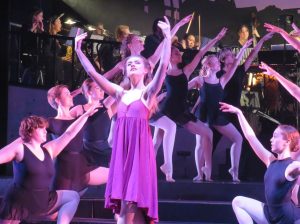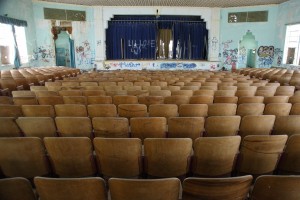The Unemotional Art of Ballet Schools
by Frankie Kuczynska | January 9, 2024
The way I talk about my time at ballet school has always been punctuated with an awkward laugh, or an unresponsive face to “oh god” as people try to react to what I have told them. I have never found it shocking, or horrifying, or abnormal in the slightest: it was all I knew from 12 onwards. My audition process for ballet school lasted three months. It began in early September 2014, with a Saturday morning ballet class, the headteacher watching. After this audition, they told my mum that they wanted me to come and take their extracurricular classes twice a week, where they would monitor my progress, before reassessing and coming to a decision. So twice a week after school, I would take the tube from Islington to Shepherds Bush, and take classes at my local dance school four times a week. After a re-assessment in late November, they accepted me—telling me I was behind and needed to work to catch up. But they could tell how much I loved to dance, and that they were willing to take a chance on me. At that time, dance was all I wanted to do. I copied the Royal Ballet’s The Nutcracker religiously in my bedroom, transfixed by the beauty, love, and joy that I saw infused into their dancing. I started the following term, in January 2015, and stayed there until I was 16 when the school stopped. It was over the last year that I began to disconnect fully from dance, a gradual process which meant that I gave up on the hope of a career as a ballet dancer. Dance was no longer something I viewed as beautiful. The Nutcracker music was met with nothing but faint nausea, and pity for the corps de ballet dancers I watched on the sidelines, exhaustion hidden behind a sickly-sweet smile.
Almost 9 years after my first audition, the Panorama documentary The Dark Side of Ballet Schools aired on BBC One. This was accompanied by a BBC news article. I watched the documentary the day it came out, having been made aware of it by a former ballet teacher of mine. My initial reaction to the new BBC documentary series was not one I am especially proud of. When the episode started, and the young men and women came forward about the mistreatment they experienced, my first thought was “yeah… and?”. The shock value of the program was lost on me. Their stories were ones I had lived and heard time and time again. The following day, The Telegraph, The Times, The Daily Mail, and the Evening Standard all released articles on the subject. BBC Radio 4 aired a radio accompaniment to the documentary, expanding upon and adding to the testimonies of dancers who have been left with the lasting effects of this abuse. I still found it difficult to become actively outraged. To me, my ballet school experience was one that I had left behind, only brought out for a good anecdote on a first date, or when asked for a fun fact at job interviews.
Over the following days, I found it unexpectedly hard to let go of the documentary. I was fine—I was sure that I had long been at peace with what I had gone through. But I found myself obsessed. I read each news outlet’s article on the story obsessively, online stalked the lawyer representing the dancers who had decided to sue the schools, and spent hours recounting my own experience. It has never been a secret that dancers are more likely to struggle with disordered eating, and every now and then a big story of abuse will be released. However, these stories brought up memories I had decided to forget, and the more I thought, the more I was able to remember the experience as layered and complex, not just one-liners about my weight and appearance. The way girls would say they missed a period in the changing rooms before class, a sign they had achieved the ‘ballet body’, masking pride with fake concern. Each missed period fed into the internal hierarchy of girls in the year, a symbol that you were working harder than your peers. It demanded respect and fear. I remember waiting for class, when one of my peers came in laughing about how she had been told to cut out carbs, a laughter coated in insecurity. I remember the sense of fear that I would be told the same thing, and the relief that it wasn’t me that time. It’s not like we ate unhealthily at all—there was a list of food items that we were not allowed in school, enshrined within the safeguarding policy. Being told that I danced like a Christmas pudding, and needed to be more like a breadstick—that particular incident was in my first week at school—potentially remains the most humiliating moment of my life. Seeing the public shock at these experiences which were the norm, I was forced to confront what I had decided to forget.
The more and more I remembered, the more frustrated I became with the form of news coverage. These news articles have allowed for a conversation to begin. However, the shock factor headlines of ‘Students Accuse Top Ballet Schools of Bullying and Body Shaming’ ignore so much of the nuance and complexity of the experience. It is more than just body shaming. These schools must be held accountable, and brave dancers such as Ellen Elphick are doing so through legal action, but the conversation needs to broaden beyond just shock stories of blatant body shaming and abuse. I felt that so much was not being recognised, and something I found myself returning to was how emotionless it all was. More than that, emotion was seen as a failing, something to be hidden and kept out of sight. This not only affects the relationships that adolescents are able to form within these schools, but is actually a detriment to the art on the whole. Every Nutcracker I performed while at school felt further and further removed from dancing in my room as a kid. I was absent, dancing the same steps year in year out, detached from the performance and art form.
Ballet is extremely competitive. The competitive environment fostered within schools is justified by the reasoning that it is “preparing you for the industry”. Within my first month at the school, one of the teachers said in front of the whole school to be careful as “the person sitting next to you could be auditioning you one day”. Whilst ultimately not an untrue statement, this sentiment is not one that aids in forming healthy bonds as a 13-year-old. The idea that your career could ultimately rest upon your peers is unsurprisingly not going to be conducive to normal, healthy relationships. All the girls in my year were aware of the moments we would transform from friends into competitors: the dreaded upper school auditions in year 11, the annual Nutcracker auditions, and the yearly assessments. The tensions were most notable between the girls who were poised at the top of the ‘hierarchy’ of our year, those competing for the top roles and best schools. The first time we saw each other after the Year 11 cast list was dropped, silence followed the girl who had got the lead, her presence halting the whispered conversations about how unfair it was. Birthday parties were dominated by conversations bitching about the amount of attention one student was getting, how they did not deserve it. Shopping trips summed up by the snide line “you’re so lucky you have boobs, I could never pull that off” or backhanded compliments of the same nature. This is not to say that I don’t have some wonderful and meaningful friendships from my time at school, but I do envy those who have extended, close-knit groups of friends from school.
The idea of ‘preparing you for the industry’ also cultivates a subordinate student-teacher relationship. You bow when the teacher walks in, you are not allowed to yawn or cry in front of them. I remember crying in the bathroom while the first group did the exercise, then walking out and joining the second group as if nothing was wrong. You cannot fold your arms or lean on the barre. You cannot talk at all during class. Anything they suggest must be taken as true, and you must be grateful for any attention, even if it is humiliation. It will only make you stronger and you are lucky they care enough about your improvement. Every day I was told that I was so lucky to be there. There are hundreds of other girls they could have chosen instead of you. And up until Year 10, they might, and I may well be, assessed out. If you are ever unhappy there, you are ungrateful. If you felt mistreated or sad or tired, you were weak and couldn’t handle a career as a ballet dancer. I believed this, and it hugely damaged my self-esteem.
I was often told that they had taken a chance on me, that I wasn’t built right for a dancer: words that made me feel so intrinsically flawed. I think this feeling in many ways contributed to my relationship with my body and food—I thought that perhaps if I looked perfect for ballet on the outside, perhaps it wouldn’t matter that I was wrong on the inside. Even then, it still was not enough to offset the gnawing feeling there was something fundamentally wrong with me. Any indication that I wasn’t perfect was a slap in the face. I dreaded the annual weigh-ins which coincided with assessments, taking the fact I weighed more than girls five inches shorter than me to be a huge failing on my part. When I stopped dancing professionally, I told myself I just wasn’t cut out for it, that falling out of love with dance was a sign of my incapability to make it. It felt inconceivable that most people would feel the same, and my lack of passion was emotional exhaustion rather than a sign of incapability. I find it hard to reconcile how I feel about my time at school with the fact that many of these teachers meant well. They do not create this environment out of spite, it is the way they were trained and so it is all that ballet knows.
We were not given the opportunity to feel like normal adolescents. Dance is an art—it is meant to be felt. How can a dancer become an artist when the practice for them is rooted in a lack of emotion? Dance, and dance training, have become an entirely insensitive thing. I don’t think that I would completely change my experience—I have no idea who or where I would be without it. I do believe that in many ways, ballet school failed me. It should be a place where emotion is encouraged and celebrated. This process would require significant collaboration across companies and schools, trying to shift the perfectionist and single-option mindset that is so entrenched across the entire industry. It would require recognising bodies as flawed things, and celebrating these flaws. It would require celebrating individuality and emotion. This would take a long time, and I don’t even know if it will ever completely change, whether audiences would be accepting of what changing ways of training would look like. I have found that most people are reluctant to separate dancers from the preconceived passive, waif-like image. However, if it makes dance more artistic and therefore a universal means of connection, perhaps they would welcome it. ∎
Words by Frankie Kuczynska. Art by Izzy Rycroft.




